The US Department of Energy (DOE) has announced an investment of $1.5 billion in four transmission projects across Louisiana, Maine, Mississippi, New Mexico, Oklahoma, and Texas.
The expansion will help support electrical grid reliability and resiliency and facilitate the uptake of low-cost clean energy.
The four projects announced for funding include:
- Aroostook Renewable Project: A new substation in Haynesville, Maine, and a 111-mile, 1,200MW transmission line connecting to ISO-NE in Pittsfield, Maine. Contract value: up to $425 million.
- Cimarron Link: A 400-mile HVDC line from Texas County to Tulsa, Oklahoma, delivering 1,900MW of wind and solar energy to eastern Oklahoma and the Southwest Power Pool. Contract value: up to $306 million.
- Southern Spirit: A 320-mile HVDC line linking the ERCOT grid with southeastern U.S. grids (MISO-S and SOCO), improving reliability during extreme weather events. It provides 3,000 MW of bidirectional capacity. Contract value: up to $360 million.
- Southline Project (Phase 2): A 108-mile transmission line delivering 1,000MW of bidirectional capacity between Hidalgo County and Las Cruces, New Mexico. Contract value: up to $352 million.
The program intends to open future funding opportunities when sufficient uncommitted funds are available.
In addition, the DOE also released the final National Transmission Planning (NTP) Study. The NTP provides long-term planning tools to assess future scenarios through 2050, aiming to maintain grid reliability, boost resilience, and lower costs while supporting evolving energy needs.
The study concludes that US transmission capacity must double or triple by 2050 to meet demand and reliability goals, with substantial cost savings achievable through expanded transmission and interregional planning.
The announcement follows a warning by Texas' Public Utility Commission that its utilities will be unable to cope with the increased energy demand of AI-specific data centers.
Speaking to Bloomberg, Thomas Gleeson, chairman of the Public Utility Commission of Texas, asserted that data center developers must supply some of their own power if they want to connect to the Texas grid within 12 to 15 months. Many of the corporations involved, he said, have among the biggest balance sheets in the world and can afford to fund the construction of new power plants.
These concerns are part of the broader issue of rising data center power consumption levels across the US, with the US data center market set to reach 35GW by the end of the decade.
The DOE's investment is part of a broader effort from the ministry to address growing power use. In August, the DOE’s advisory board proposed several ways to address the growing challenge of AI data center power use and its impact on the grid.
Among the numerous proposals, the board suggested building an AI data center for national labs, academia, and industry "to collaborate in development and assessment of algorithms for energy-efficient and/or energy-flexible AI training and inference."
Unless significant progress is made energy constraints are likely one of the biggest emerging bottlenecks for AI data center buildout. Meta CEO Mark Zuckerberg highlighted this point stating: “We would probably build out bigger clusters than we currently can if we could get the energy to do it."
More in The Critical Power Channel
-

-

-

Episode How much power does AI demand?



